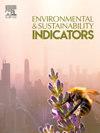不同农林业系统与气候带和土壤类型间生物量和土壤碳储存和固存率的变化
IF 5.4
Q1 ENVIRONMENTAL SCIENCES
引用次数: 0
摘要
农林复合系统在环境管理和农田碳固存方面获得了很大的兴趣。生物量和土壤碳的预期变化是农田温室气体减缓的主要不确定领域之一。全球综合碳储量、固存率和不同农林业系统的不确定性实际上是缺乏的。因此,本研究的目的是:(1)量化不同气候带和土壤类型的不同农林业系统的碳储量和固碳率;(2)评估估算不同农林业系统生物量、土壤碳储量和固碳率的不确定性。利用129和121项初步研究的数据,我们估计农林复合系统的全球平均碳储量在生物量中为40.9 Mg ha - 1,在100 cm深度的土壤中为159.1 Mg ha - 1。土壤中的碳储量大约是不同农林复合系统生物量的3-4倍。根据38项和27项研究的数据,我们估计农林复合系统的碳固存率分别为生物量5.7 Mg C ha−1年−1和土壤1.4 Mg C ha−1年−1。农林复合系统的平均生物量碳和土壤碳储量较高。农业系统实现了更高的生物量碳固存率,而农林系统实现了更高的土壤碳固存率。温带气候下的农林业系统比热带气候下的农林业系统储存了更高的生物量和土壤碳储量。与热带和温带地区相比,亚热带气候的农林业系统实现了更高的生物量和土壤碳固存率。农林复合系统在gleysol上储存了更多的生物量碳储量,而在arenosol上储存了更多的有机碳储量。本文首次提供了不同农林业系统中与生物量和土壤碳储量及固碳率相关的估算值和不确定性。这些估计可能提供基准值,用以判断未来的进展。通过将田间数据与基准数据进行比较,可以判断农林业的未来进展:生物量碳(40.9 Mg公顷−1)、土壤碳(159.1 Mg公顷−1)和固存率(生物量5.7 Mg碳公顷−1年−1,土壤1.4 Mg碳公顷−1年−1)。我们的研究结果也有望指导有关资源分配的规划和决策,以及利用农林干预措施制定基于证据的环境管理政策。本文章由计算机程序翻译,如有差异,请以英文原文为准。
Variation in biomass and soil carbon storage and sequestration rates in different agroforestry systems with climatic zones and soil types
Agroforestry systems have gained substantial interest in environmental management and carbon sequestration on cropland. The expected changes in biomass and soil carbon are one of the major areas of uncertainty in greenhouse gas mitigation on croplands. Global syntheses of the carbon stocks, sequestration rates, and the uncertainties in different agroforestry systems are virtually lacking. Therefore, the objective of this study are (1) to quantify carbon storage and sequestration rate of different agroforestry systems with climatic zones and soil type, and (2) to assess the uncertainties in estimating biomass, soil carbon stocks, and sequestration rates across agroforestry systems. Using data from 129 and 121 primary studies, we estimated the global mean carbon stocks in agroforestry systems at 40.9 Mg ha−1 in biomass and 159.1 Mg ha−1 in soil up to the 100 cm depth. Approximately 3–4 times more carbon was stored in the soil than in biomass of the different agroforestry systems. We estimated carbon sequestration rates in agroforestry systems at 5.7 Mg C ha−1 year−1 in biomass and 1.4 Mg C ha−1 year−1 in the soil using data from 38 and 27 studies, respectively. Agrosilvopastoral systems stored higher mean biomass carbon and soil carbon stocks. Agrisilvicultural systems achieved higher biomass carbon sequestration rates, while agrosilvopastoral systems achieved higher soil carbon sequestration rates. Agroforestry systems in temperate climates stored higher biomass and soil carbon stocks than those in tropical climates. Agroforestry systems in subtropical climates achieved higher biomass and soil carbon sequestration rates compared to tropical and temperate regions. Agroforestry systems stored higher biomass carbon stocks on Gleysols, while those on Arenosols stored higher SOC stocks. For the first time, here we provide estimates and uncertainties associated with biomass and soil carbon stocks and sequestration rates in different agroforestry systems. These estimates may provide benchmark values against which future progress can be judged. Future progress in agroforestry can be judged by comparing field data to benchmarks: biomass carbon (40.9 Mg ha−1), soil carbon (159.1 Mg ha−1), and sequestration rates (5.7 Mg C ha−1 year−1 in biomass, 1.4 Mg C ha−1 year−1 in soil). Our findings are also expected to guide panning and decision-making regarding allocation of resource and development of evidence-based policies for environmental management using agroforestry interventions.
求助全文
通过发布文献求助,成功后即可免费获取论文全文。
去求助
来源期刊

Environmental and Sustainability Indicators
Environmental Science-Environmental Science (miscellaneous)
CiteScore
7.80
自引率
2.30%
发文量
49
审稿时长
57 days
 求助内容:
求助内容: 应助结果提醒方式:
应助结果提醒方式:


